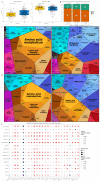Integrating TCGA and Single-Cell Sequencing Data for Hepatocellular Carcinoma: A Novel Glycosylation (GLY)/Tumor Microenvironment (TME) Classifier to Predict Prognosis and Immunotherapy Response
- PMID: 38248854
- PMCID: PMC10818448
- DOI: 10.3390/metabo14010051
Integrating TCGA and Single-Cell Sequencing Data for Hepatocellular Carcinoma: A Novel Glycosylation (GLY)/Tumor Microenvironment (TME) Classifier to Predict Prognosis and Immunotherapy Response
Abstract
The major liver cancer subtype is hepatocellular carcinoma (HCC). Studies have indicated that a better prognosis is related to the presence of tumor-infiltrating lymphocytes (TILs) in HCC. However, the molecular pathways that drive immune cell variation in the tumor microenvironment (TME) remain poorly understood. Glycosylation (GLY)-related genes have a vital function in the pathogenesis of numerous tumors, including HCC. This study aimed to develop a GLY/TME classifier based on glycosylation-related gene scores and tumor microenvironment scores to provide a novel prognostic model to improve the prediction of clinical outcomes. The reliability of the signatures was assessed using receiver operating characteristic (ROC) and survival analyses and was verified with external datasets. Furthermore, the correlation between glycosylation-related genes and other cells in the immune environment, the immune signature of the GLY/TME classifier, and the efficacy of immunotherapy were also investigated. The GLY score low/TME score high subgroup showed a favorable prognosis and therapeutic response based on significant differences in immune-related molecules and cancer cell signaling mechanisms. We evaluated the prognostic role of the GLY/TME classifier that demonstrated overall prognostic significance for prognosis and therapeutic response before treatment, which may provide new options for creating the best possible therapeutic approaches for patients.
Keywords: glycosylation modification; hepatocellular carcinoma; malignant epithelial cells; prognosis; single-cell sequencing; tumor immune microenvironment.
Conflict of interest statement
The authors declare no conflicts of interest.
Figures








Similar articles
-
Identification and Validation of a Novel Tumor Microenvironment-Related Prognostic Signature of Patients With Hepatocellular Carcinoma.Front Mol Biosci. 2022 Jun 30;9:917839. doi: 10.3389/fmolb.2022.917839. eCollection 2022. Front Mol Biosci. 2022. PMID: 35847972 Free PMC article.
-
Identification of Novel Tumor Microenvironment-Related Long Noncoding RNAs to Determine the Prognosis and Response to Immunotherapy of Hepatocellular Carcinoma Patients.Front Mol Biosci. 2021 Dec 24;8:781307. doi: 10.3389/fmolb.2021.781307. eCollection 2021. Front Mol Biosci. 2021. PMID: 35004851 Free PMC article.
-
The combined signatures of telomere and immune cell landscape provide a prognostic and therapeutic biomarker in glioma.Front Immunol. 2023 Aug 17;14:1220100. doi: 10.3389/fimmu.2023.1220100. eCollection 2023. Front Immunol. 2023. PMID: 37662954 Free PMC article.
-
Characterizing the key genes of COVID-19 that regulate tumor immune microenvironment and prognosis in hepatocellular carcinoma.Funct Integr Genomics. 2023 Aug 4;23(3):262. doi: 10.1007/s10142-023-01184-z. Funct Integr Genomics. 2023. PMID: 37540264
-
The combined signatures of hypoxia and cellular landscape provides a prognostic and therapeutic biomarker in hepatitis B virus-related hepatocellular carcinoma.Int J Cancer. 2022 Sep 1;151(5):809-824. doi: 10.1002/ijc.34045. Epub 2022 May 9. Int J Cancer. 2022. PMID: 35467769 Free PMC article.
Cited by
-
Targeting Sodium Transport Reveals CHP1 Downregulation as a Novel Molecular Feature of Malignant Progression in Clear Cell Renal Cell Carcinoma: Insights from Integrated Multi-Omics Analyses.Biomolecules. 2025 Jul 15;15(7):1019. doi: 10.3390/biom15071019. Biomolecules. 2025. PMID: 40723891 Free PMC article.
-
Bulk and single-cell RNA sequencing identify prognostic signatures related to FGFBP2+ NK cell in hepatocellular carcinoma.PeerJ. 2025 May 20;13:e19337. doi: 10.7717/peerj.19337. eCollection 2025. PeerJ. 2025. PMID: 40416605 Free PMC article.
-
Glycomics in Human Diseases and Its Emerging Role in Biomarker Discovery.Biomedicines. 2025 Aug 21;13(8):2034. doi: 10.3390/biomedicines13082034. Biomedicines. 2025. PMID: 40868286 Free PMC article. Review.
References
Grants and funding
LinkOut - more resources
Full Text Sources

